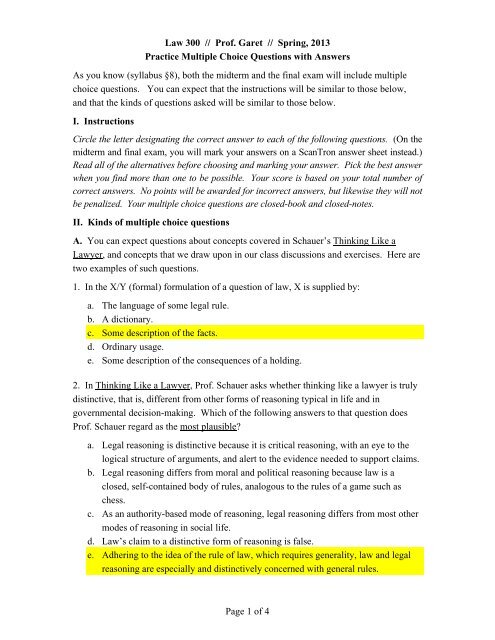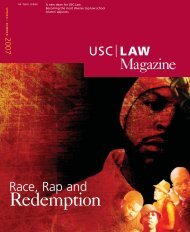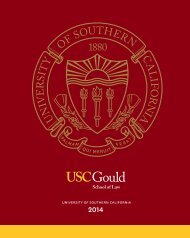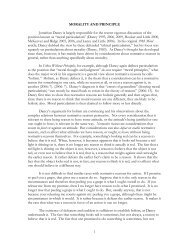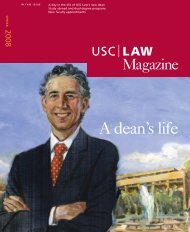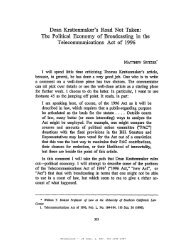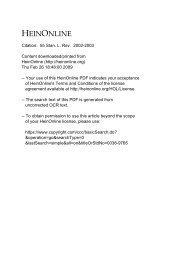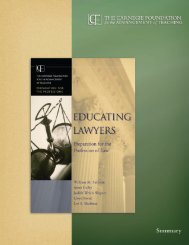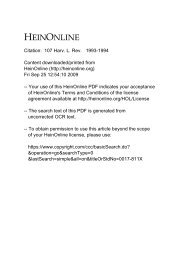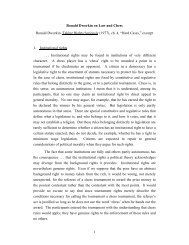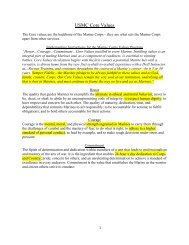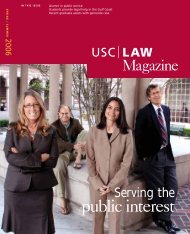Part I: Multiple Choice Questions - USC Gould School of Law
Part I: Multiple Choice Questions - USC Gould School of Law
Part I: Multiple Choice Questions - USC Gould School of Law
- No tags were found...
Create successful ePaper yourself
Turn your PDF publications into a flip-book with our unique Google optimized e-Paper software.
B. You can expect questions that track our class discussion <strong>of</strong> the main cases. Suchquestions would not be about details, such as who wrote the majority opinion in Smith, orwhich state supreme court decided Blanchflower. Instead, the questions would explorelegal reasoning. Here are two examples <strong>of</strong> such questions.3. At T1, the Supreme Court decided Smith. At T2, Mr. Watson traded illegal drugs fora firearm, and was convicted in the trial court. At T3, the Supreme Court has agreed todecide whether Watson’s conduct counts as “using a firearm” within the meaning <strong>of</strong> thesentence-enhancement statute. You represent Watson (you are part <strong>of</strong> the legal teamdefending him) and you are preparing for oral argument before the Supreme Court. Inyour argument, you plan to:a. Argue that the holding in the Smith case is best stated at a low level <strong>of</strong> generalityrather than a high level <strong>of</strong> generality.b. Urge the Court to assign more weight to the sentence-enhancement statute’spolicy goals than to the ordinary meaning <strong>of</strong> “uses a firearm.”c. Argue that in ordinary language, one who pays $1.00 for a cup <strong>of</strong> c<strong>of</strong>fee has“used” the dollar in the course <strong>of</strong> the transaction, but has not “used” the c<strong>of</strong>fee.d. Rely, as your strongest argument, on the historical fact that when Congressenacted the statute, it never thought <strong>of</strong> the fact pattern in which defendant tradesillegal drugs for a firearm.e. (a) and (c)4. In Garratt v. Dailey, the Washington State Supreme Court decided that:a. When Brian moved the chair, he knew to a substantial certainty that Ruth wouldattempt to sit where the chair had been.b. A minor can be liable for battery only if he or she has an estate from which he orshe could pay an award <strong>of</strong> damages.c. Knowledge to a substantial certainty that a harmful contact will result, counts asan intent to bring about a harmful contact, and thus satisfies the intent requirementfor battery.d. Like having an intention to do a particular act, knowing that one is doing aparticular act satisfies the volitional act requirement for battery.e. The case should be remanded to the trial court, with instructions to determinewhether Brian had a purpose to harm Ruth or play a prank on her, when he movedthe chair.Page 2 <strong>of</strong> 4
C. You can expect short fact-patterns followed by questions that ask you to apply legalreasoning to the fact-patterns. Here are two examples <strong>of</strong> such questions.5. In the state <strong>of</strong> West Dakota, appeals from trial court decisions are randomly assignedto one <strong>of</strong> two appellate courts. Cases A, B, C, and D arise under the ordinance thatprohibits bringing a vehicle into the park. An appellate court in the state <strong>of</strong> West Dakotais hearing case D. Cases A, B, and C were previously decided by the other West Dakotaappellate court. The decisions in cases A, B, C, and D are as follows:Case A: Aaron rode his Harley into the park. The trial court decided that Aaronviolated the ordinance. The appellate court upheld that decision.Case B: Barbara rode her bicycle into the park. The trial court decided that Barbaraviolated the ordinance. The appellate court upheld that decision.Case C: Charlene rode her tricycle into the park. The trial court decided thatCharlene did not violate the ordinance. The appellate court upheld that decision.Case D: Doris brought her red wagon into the park. The trial court decided thatDoris did not violate the ordinance. That decision is now on appeal in the other WestDakota appellate court (not the appellate court that decided cases A, B, and C).Which <strong>of</strong> the following statements about the precedential effect on D <strong>of</strong> the otherappellate court’s decisions in cases A, B, and C, is least plausible?a. Because the sister appellate court’s decisions in cases A, B, and C do not stateholdings, they do not serve as precedent that bears on the other appellate court’sdecision in case D.b. The judgments <strong>of</strong> the appellate court, affirming the decisions <strong>of</strong> the trial court incases A, B, and C, are vertical precedent that bears on the decision <strong>of</strong> the trialcourt in case D.c. Because cases A, B, and C might stand for the proposition that the risk <strong>of</strong> physicalinjury to park-goers is part <strong>of</strong> the determination <strong>of</strong> whether an action counts asbringing a vehicle into the park, the appellate court in case D should ask whetherthe risk <strong>of</strong> injury to park-goers from defendant’s bringing a red wagon into thepark is more comparable to the risk <strong>of</strong> injury to park-goers from defendant’sriding a Harley or bicycle, or more comparable to the risk <strong>of</strong> injury to park-goersfrom defendant’s riding a tricycle.d. Two or more propositions might explain the outcomes in cases A, B, and C; andthe appellate court in case D should consider such propositions, asking which <strong>of</strong>them brings out the ordinance’s latent justification and makes the ordinance thebest it can be.e. In relation to the appellate court faced with case D, the decisions <strong>of</strong> the appellatecourts in cases A, B, and C are horizontal precedents <strong>of</strong> a sister court.Page 3 <strong>of</strong> 4
6. An ordinance <strong>of</strong> the City <strong>of</strong> <strong>Gould</strong> prohibits “bringing a vehicle into the park.” Ronwalked to the park, pushing Junior in his stroller (baby buggy). When he got to the park,and continued pushing Junior in his stroller within the park, <strong>Gould</strong> charged Ron withviolating the ordinance. Which <strong>of</strong> the following has the least bearing on a reasonabletrial court’s analysis <strong>of</strong> the question <strong>of</strong> law in the stroller case?a. Whether violation <strong>of</strong> the ordinance is a crime (that is, whether the violator facescriminal liability).b. Whether the background justification <strong>of</strong> the ordinance would be served bytreating pushing a baby in a stroller as bringing a vehicle.c. Whether the background justification <strong>of</strong> the ordinance, together with thebackground justification for having parks, would be served by treating pushing ababy in a stroller in a park as an instance <strong>of</strong> bringing a vehicle into the park.d. Whether Ron knew, when he entered the park, that there is a <strong>Gould</strong> ordinance thatprohibits “bringing a vehicle into the park.”e. Whether, in ordinary language, a stroller could be described as a “vehicle.”Page 4 <strong>of</strong> 4


